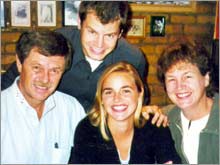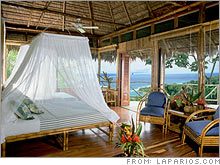Business in the making
John and Karen Lewis abandoned a comfortable life for an adventurous one.
But they never forgot their Peace Corps years in Kenya, where they taught school. In 1988, they returned there for five weeks. "We had an incredible time," says John, now 61. "We visited our old school where our students were now principals and teachers themselves." Back in Minneapolis, he wondered, "What am I doing here?" Answering that took a year. "Karen and I started working with a career counselor" to figure out what they should do. The counselor asked them what they wanted. "'Adventure," said John, suggesting a new country and an entirely new field. The counselor's terse reply: "That's a recipe for failure." The adventure begins John felt that when the couple took risks they landed on their feet. So on January 11, 1990, he quit his law practice. He and Karen set out to open an ecotourist business. No one could believe it. "I got a call from a judge who asked, 'Is it alcohol? Another woman? People can help you with this.'" An investment banker warned about using profit-sharing and pension plan assets to finance the undertaking. John ignored the advice. The couple had a net worth of $1.3 million, but had earmarked some for college. (Son Andrew got a doctorate from Yale and teaches history at American University. Daughter Wendy is in the residency program at University of Washington Hospital in Seattle.) The inital idea was a primitive eco-lodge in Costa Rica. The couple sent questionnaires to travel agents asking if the agents would direct business their way. The unanimous answer: no! "They said there are too many rustic destinations," remembers John. "But if we built a high-end business, not only would they send us business, they would fill us up." In August 1990, John found a pristine rainforest with ocean frontage and abundant wildlife on Costa Rica's Osa Peninsula. The 1,000-acre tract cost four times the budgeted $100,000. A Costa Rican consultant worked out the business plan. "He suggested we have a party," says John. "We met all our neighbors, who were living in the hills. We felt vulnerable until we made friends. We asked them what they most wanted and they all said a school." The Lewises started a board of education, got U.S. volunteers and the Army Corps of Engineers to help their neighbors put up a building. They then gave it to the government, which provided staff and curriculum. Meanwhile, the Lewises lived in a falling-down hut. "There were scorpions in the roof. We had a coral snake under our bed," says John. "We got to know a lot about the people. Who was on drugs, who drank, who was reliable, who had a truck." He had admired many well-built, thatched-roofed ranchos in the area and one builder's name – Alfredo Rosales – kept coming up. John contacted Rosales, but the builder was skeptical at first. "I kept going to his house," says John. "He started talking to me and he agreed to build." Then on December 14, 1991, two weeks before construction was scheduled to begin, Rosales opted out. "He talked about all the problems. I told him, 'You'll solve them as they come up.' He told me, 'I want you to do an article in the paper about all the rancheros I've built.'" John agreed and building began. By now, money had run low. "We incurred $250,000 in tax penalties by cashing in our pensions and profit-sharing plans," says John. Luckily, the IRS announced an installment payment program and the couple made arrangements to pay the debt off gradually. They borrowed money from an uncle and a friend to complete the lodge. Not so grand opening Lapa Rios opened with six bungalows on January 20, 1993. Everyone worked around the clock the last week, and Canadian tourists arrived that day. John and Karen built the business on word-of-mouth. The place eked out a profit the first year, and now produces annual earnings that are well into six figures. It has 16 bungalows, 53 full-time workers, and an occupancy rate of more than 95 percent during high season and 75 percent overall. Room rates, high for Costa Rica, start at $178 per person a night, double occupancy (including meals), and $222 a night in high season. John says the business is worth about $4.5 million even though most of the property is permanently preserved and can't be developed. The couple's lives have changed in many ways. Sadly, their 38-year marriage ended a year and a half ago -- although John claims they're better friends than ever -- and she only spends a week or 10 days every two months in Lapa Rios. They intend to sell the hotel soon, one of the reasons for they hired professional management a few years ago. (The other was that they were working 12 to 14 hours a day.) A remnant of land along the beach will remain in the family. That was son Andrew's idea. "He said the whole family sacrificed so much for this, he wanted part of it to keep," says John. |
 |
||||||||||||||||||||||||||||||



